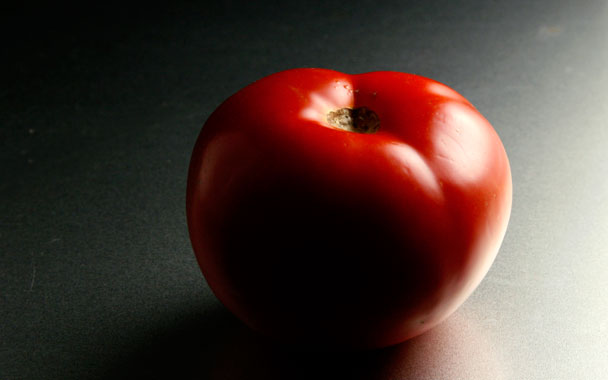How in the hell does salmonella get inside a tomato?
Excuse the bluntness, but that question has been much on my mind this week in the wake of the Food and Drug Administration’s (FDA) warnings against eating raw red tomatoes. The agency took action after 145 diners in 16 states were sickened by tomatoes tainted with salmonella, a bacteria carried in the intestines of animals and humans.
After making several calls and receiving no satisfactory answer to my simple question, I finally reached David Gombas, senior vice president of food safety and technology at the United Fresh Produce Association, a trade organization. He frankly admitted that while there are a number of potential ways for salmonella bacteria to get from some animal’s intestines into your fresh salsa, the exact mechanism remains a food-safety mystery that the industry would dearly love to solve. This explains why outbreaks of the disease are so common. The Center for Science in the Public Interest (CSPI) says that more than 3,000 Americans have been sickened by tomatoes in 24 different outbreaks since 1990, a number that looks even more sobering when you realize that the Center for Disease Control and Prevention estimates that only 1 in 30 salmonella cases ever gets reported.
Gombas did say that there were several prime suspects in the transmission of salmonella from feces to fruits:
· Irrigation. If the water is contaminated with salmonella, it can get on the crops.
· Fertilization. Animal manure of any type harbors the bacteria.
· People. Anyone who picks, processes, or packs the tomatoes can manually transfer contaminants.
· Animals. Everything from the large (cows, wild pigs) to the tiny (mice, songbirds) can introduce the germs into fields, either with their own feces, or by having stepped in another animal’s feces.
Tomatoes might be particularly susceptible because the slow-maturing plants spend months out in open fields.
That all explains how fecal matter gets on tomatoes. But contamination that’s on the outside of the fruits gets killed in a chlorine bath the moment a truckload arrives at the packing plant. Not so for any pathogens safely living inside the tomatoes. How does salmonella get inside?
Gombas suggested two possibilities: through cuts or scars on the skin, or through the permeable scar left where the stem was attached.
But researchers have yet to explain how a few tomatoes infected in this way can result in a nationwide disease outbreak. “We’re all hoping that at the end of its investigation of this outbreak, the FDA will uncover the trigger and then we’ll be able to fix it,” Gombas said.
The CSPI is far less sanguine. Since 2006, that consumer advocacy group has been urging the FDA to require that all farms that feed the public adhere to written food-safety plans.
Good luck. The FDA has consistently shown that it is more interested in protecting the interests of the agriculture industry than the health of American consumers. Note the confusing, back-assward way it issued its warning, listing 16 states and countries whose tomatoes were considered safe to eat, but omitting regions that were possibly unsafe. I’ll make the warning a little more consumer friendly: Avoid red round, plum, and Roma tomatoes (though those sold attached to the vine are okay) from Florida (unless they have a certificate from the state department of agriculture) and Mexico.
The current system, says the CSPI, is ineffective. “All consumers can do is cross their fingers and hope.”




 Pinterest
Pinterest


